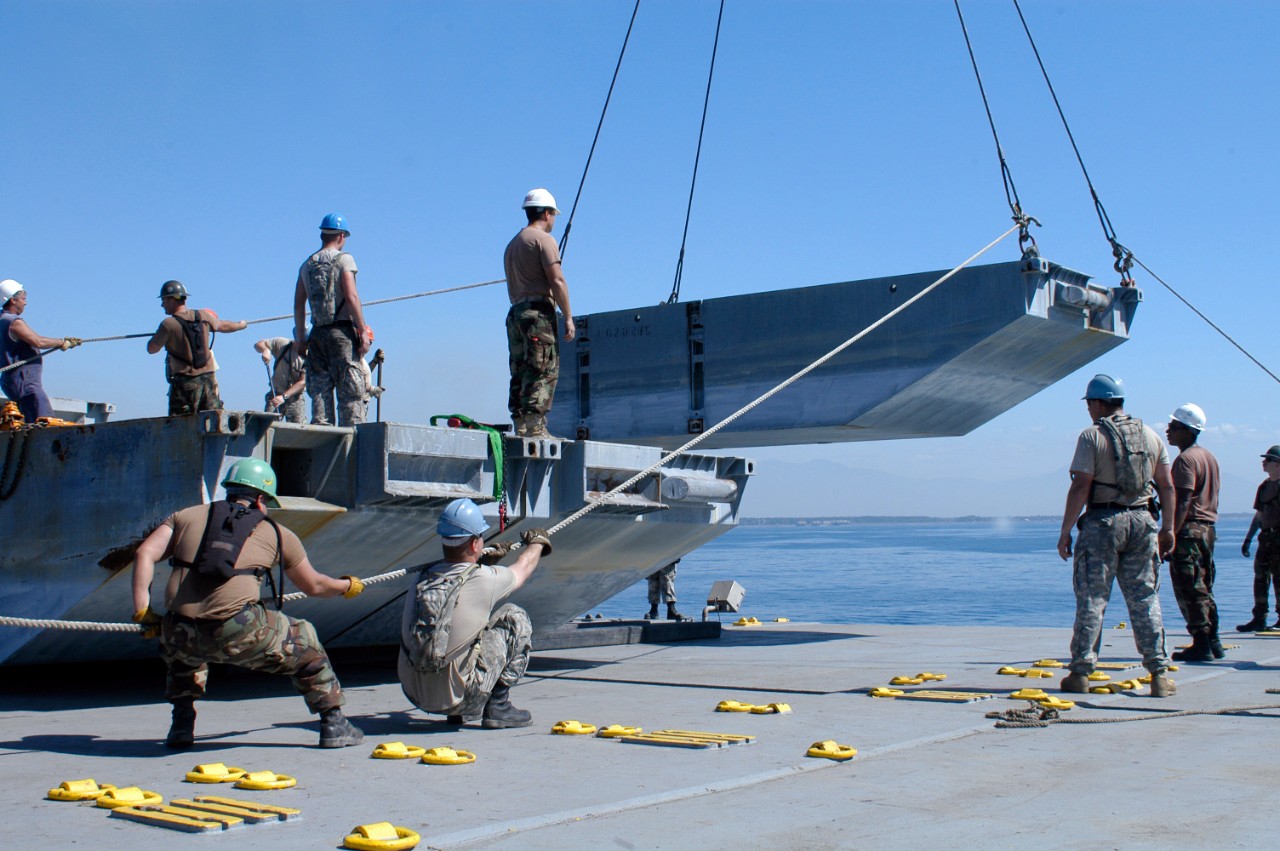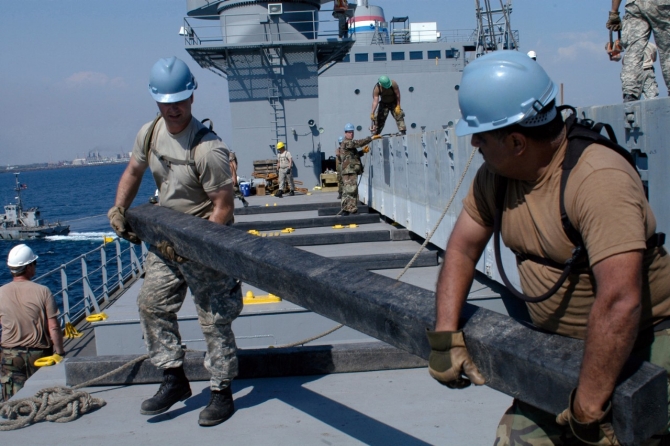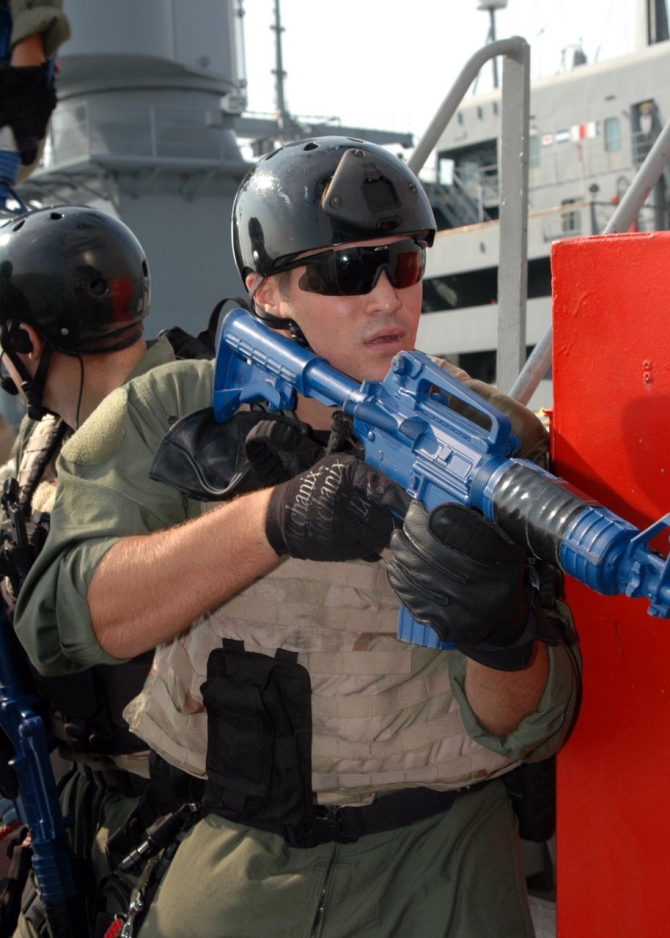Flickertail State (T-ACS-5)
1988–
The first U.S. Navy ship named Flickertail State, a nickname for the state of North Dakota.
(T-ACS-5: displacement 31,500; length 610'; beam 78'; draft 31'; speed 17 knots; complement 32; armament none; class Keystone State)
Container ship Lightning (MA-206) was laid down on 14 February 1967 at Bath, Maine, by Bath Iron Works; launched on 11 May 1968; entered service with American Export-Isbrandtsen Lines, Inc. (Mediterranean Marine Line, Inc.) on 21 February 1969; sold to Farrell Lines, Inc., in 1978; acquired by the Maritime Administration on 15 December 1986; laid-up in the James River Reserve Fleet, Va.; sponsored by Mrs. Elaine Costello, wife of Robert B. Costello, Under Secretary of Defense for Acquisition; renamed Flickertail State (T-ACS-5) on 13 June 1986. After conversion to an auxiliary crane ship at Norfolk Shipbuilding & Drydock Corp., Norfolk, Va., Flickertail State was placed in service with the Military Sealift Command (MSC) on 6 February 1988.



In the summer of 2008, Flickertail State took part in Pacific Strike 2008, a joint logistics over the shore exercise involving more than 3,000 servicemembers and civilians. Joint logistics over the shore, or JLOTS, is the U.S. military’s method of transporting military and humanitarian cargo to shore from ships at sea. This capability allows the Department of Defense to deliver cargo even where port facilities are nonexistent, damaged, or inadequate. The exercise’s objective was to rehearse and demonstrate JLOTS capabilities while at the same time conducting a real-world mission: delivering nearly 1,000 vehicles and more than 500 containers of equipment from the Army’s 3rd Brigade, 25th Infantry Division, and the 45th Sustainment Brigade, to the National Training Center at Fort Irwin, Calif. The Hawaii-based soldiers were to join their equipment at Fort Irwin for additional training, prior to deploying to Iraq later that year.
In addition to Flickertail State, the MSC assigned large, medium-speed, roll-on/roll-off ship Pililaau (T-AKR-304) to the exercise, together with two ships activated from the Maritime Administration’s Ready Reserve Force: heavy-lift ship Cape Mohican (T-AKR-5065) and transport oiler Chesapeake (T-AOT-5084). The ships operated in three phases — deployment, execution, and redeployment. Cape Mohican arrive first off the coast of Camp Pendleton during the deployment phase, dropping anchor on 23 June 2008. She delivered Navy motorized and non-motorized barges, and came about on 29 June. The following day, Flickertail State reached the area, carrying more than 350 pieces of cargo, materials that Navy Seabees would use to construct a temporary pier, called an elevated causeway, on the beach to receive cargo when it reached the shore. Chesapeake arrived on 8 July and discharged more than 200,000 gallons of water in a demonstration of her ability to pump fuel to shore. With the pumping demonstration complete, Chesapeake provided fuel to the 39 USN and USA watercraft involved during the next 20 days as part of the exercise.
Pililaau, carrying nearly 1,000 wheeled and tracked vehicles and more than 500 containers of equipment, arrived last, on the afternoon of 21 July. That day, the ship opened her ramps onto floating barges, standing by to deliver cargo to shore. At 0820 the next morning, she began off-loading and continued until just before midnight on 27 July. Pililaau’s two shipboard, 110-ton cranes lifted containers from the weatherdeck onto barges that transported the equipment to shore. Concurrently, servicemembers drove tanks, trucks, and other vehicles down her stern and side ramps onto one of two floating platforms of shallow-draft barges. The vehicles were then driven onto the watercraft for transfer ashore. At the beach, servicemembers transferred the cargo to shore via a temporary pier that Navy Seabees built in the weeks leading up to the offload. Once ashore, soldiers staged the equipment, which traveled via local roads to Fort Irwin.
“The only way to move massive amounts of equipment to our military forces or to people in need is by ship,” Brig. Gen. Mark MacCarley, USA, deputy commander of the 8th Theater Sustainment Command, which was responsible for oversight of the exercise, explained. “If there isn’t a port, we still need the capability to get our equipment to shore.”
Detailed history pending.
Mark L. Evans
4 January 2016


